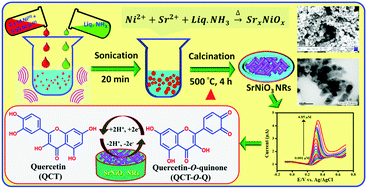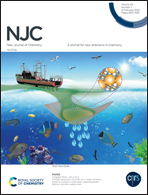Sr-Doped NiO3 nanorods synthesized by a simple sonochemical method as excellent materials for voltammetric determination of quercetin†
Abstract
The simple and novel surfactant-free synthesis of flower-like strontium-doped nickel oxide nanorods (SNO NRs) via a simple sonochemical co-precipitation method was used for electrochemical sensing of quercetin (QCT). The structure and morphology of the as-synthesized flower-like SNO NRs were characterized using various spectroscopic techniques. Then, CV, EIS, and DPV were used to examine their electrochemical properties. The effective loading concentration, pH, scan rate and stability of the SNO NR-modified electrodes were studied. Under optimized conditions, the electrochemical detection of QCT demonstrated a low detection potential of 0.3 V (vs. Ag/AgCl), and achieved a higher oxidation peak current compared to those of other modified electrodes in PB (pH 5.0). The voltammetric current response was found to linearly increase with an increasing concentration range from 0.01–68.53 μM, along with a low detection limit of 1.98 nM, and a high sensitivity of 2.1055 μA mM cm−2. The sensor also shows good selectivity and satisfactory recovery for real sample (apple and grape juice) analysis.



 Please wait while we load your content...
Please wait while we load your content...